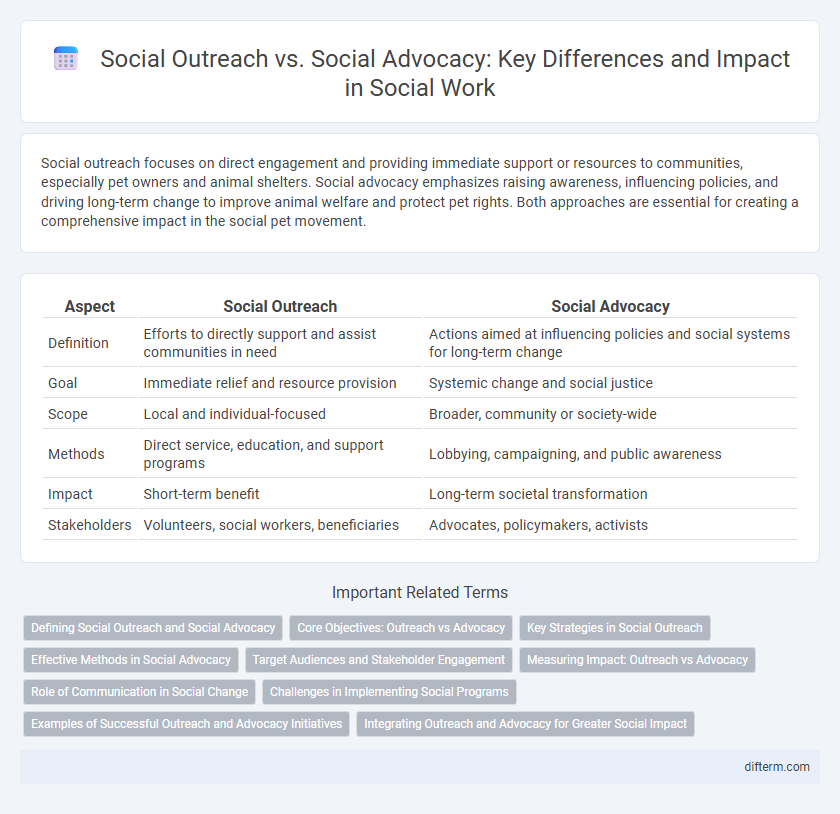Social outreach focuses on direct engagement and providing immediate support or resources to communities, especially pet owners and animal shelters. Social advocacy emphasizes raising awareness, influencing policies, and driving long-term change to improve animal welfare and protect pet rights. Both approaches are essential for creating a comprehensive impact in the social pet movement.
Table of Comparison
| Aspect | Social Outreach | Social Advocacy |
|---|---|---|
| Definition | Efforts to directly support and assist communities in need | Actions aimed at influencing policies and social systems for long-term change |
| Goal | Immediate relief and resource provision | Systemic change and social justice |
| Scope | Local and individual-focused | Broader, community or society-wide |
| Methods | Direct service, education, and support programs | Lobbying, campaigning, and public awareness |
| Impact | Short-term benefit | Long-term societal transformation |
| Stakeholders | Volunteers, social workers, beneficiaries | Advocates, policymakers, activists |
Defining Social Outreach and Social Advocacy
Social outreach involves proactive efforts to connect with and provide resources or support to underserved communities, focusing on direct engagement and assistance. Social advocacy centers on influencing public policy and societal attitudes to address systemic issues and promote social justice. These approaches differ in scope, with outreach targeting immediate needs and advocacy aiming for long-term structural change.
Core Objectives: Outreach vs Advocacy
Social outreach aims to provide immediate support and resources to underserved communities by connecting individuals with essential services like healthcare, education, and housing. Social advocacy focuses on systemic change by influencing policies, raising public awareness, and mobilizing collective action to address root causes of social issues. Outreach targets direct assistance and engagement, while advocacy prioritizes long-term structural reform and social justice.
Key Strategies in Social Outreach
Key strategies in social outreach prioritize community engagement through direct communication and resource distribution to address immediate needs effectively. Utilizing data-driven approaches enhances targeting accuracy, ensuring interventions reach vulnerable populations and build trust within communities. Leveraging partnerships with local organizations amplifies outreach efforts, fostering sustainable support networks that empower beneficiaries.
Effective Methods in Social Advocacy
Effective methods in social advocacy include strategic communication, grassroots organizing, and policy engagement. Utilizing data-driven campaigns and amplifying marginalized voices foster impactful societal change. Digital platforms and coalition-building enhance outreach, ensuring advocacy efforts reach diverse and influential audiences.
Target Audiences and Stakeholder Engagement
Social outreach targets specific communities or vulnerable groups by providing direct services, aiming for immediate impact and relationship-building. Social advocacy focuses on influencing broader policy changes and public attitudes, engaging diverse stakeholders including policymakers, organizations, and the general public. Effective stakeholder engagement in advocacy involves coalition-building and sustained communication to amplify collective voices and drive systemic change.
Measuring Impact: Outreach vs Advocacy
Measuring impact in social outreach primarily involves quantifying immediate community engagement and participation rates, whereas social advocacy focuses on assessing long-term policy changes and shifts in public behavior. Outreach metrics often include event attendance, resource distribution, and direct feedback, while advocacy impact requires tracking legislative progress and cultural transformation indicators. Combining both quantitative data and qualitative analysis offers a comprehensive understanding of social initiatives' effectiveness.
Role of Communication in Social Change
Effective communication serves as the foundation for both social outreach and social advocacy, driving awareness and inspiring collective action. Social outreach primarily utilizes targeted messaging to engage specific communities and provide direct support, while social advocacy employs strategic communication to influence public policy and societal norms. Harnessing storytelling and persuasive dialogue, communication bridges the gap between individual needs and systemic transformation in social change initiatives.
Challenges in Implementing Social Programs
Implementing social programs faces challenges such as limited resources, community resistance, and inadequate stakeholder engagement, which can hinder both social outreach and social advocacy efforts. Social advocacy often requires sustained policy changes and systemic shifts, encountering institutional barriers and political opposition. Social outreach programs struggle with effectively reaching marginalized populations and measuring long-term impact, necessitating adaptive strategies and robust monitoring systems.
Examples of Successful Outreach and Advocacy Initiatives
Social outreach initiatives like Habitat for Humanity have successfully provided housing to low-income families, demonstrating community-driven impact. Social advocacy campaigns such as the LGBTQ+ rights movement have influenced legislative changes and increased societal acceptance through sustained public engagement. Both approaches leverage grassroots involvement and media strategies to amplify their effectiveness in creating social change.
Integrating Outreach and Advocacy for Greater Social Impact
Integrating social outreach and social advocacy strengthens community engagement by combining direct support with systemic change efforts. Outreach provides immediate assistance and builds trust within affected populations, while advocacy addresses underlying policy issues to create lasting solutions. Strategic collaboration between these approaches amplifies social impact, ensuring both urgent needs and long-term goals are met effectively.
social outreach vs social advocacy Infographic

 difterm.com
difterm.com